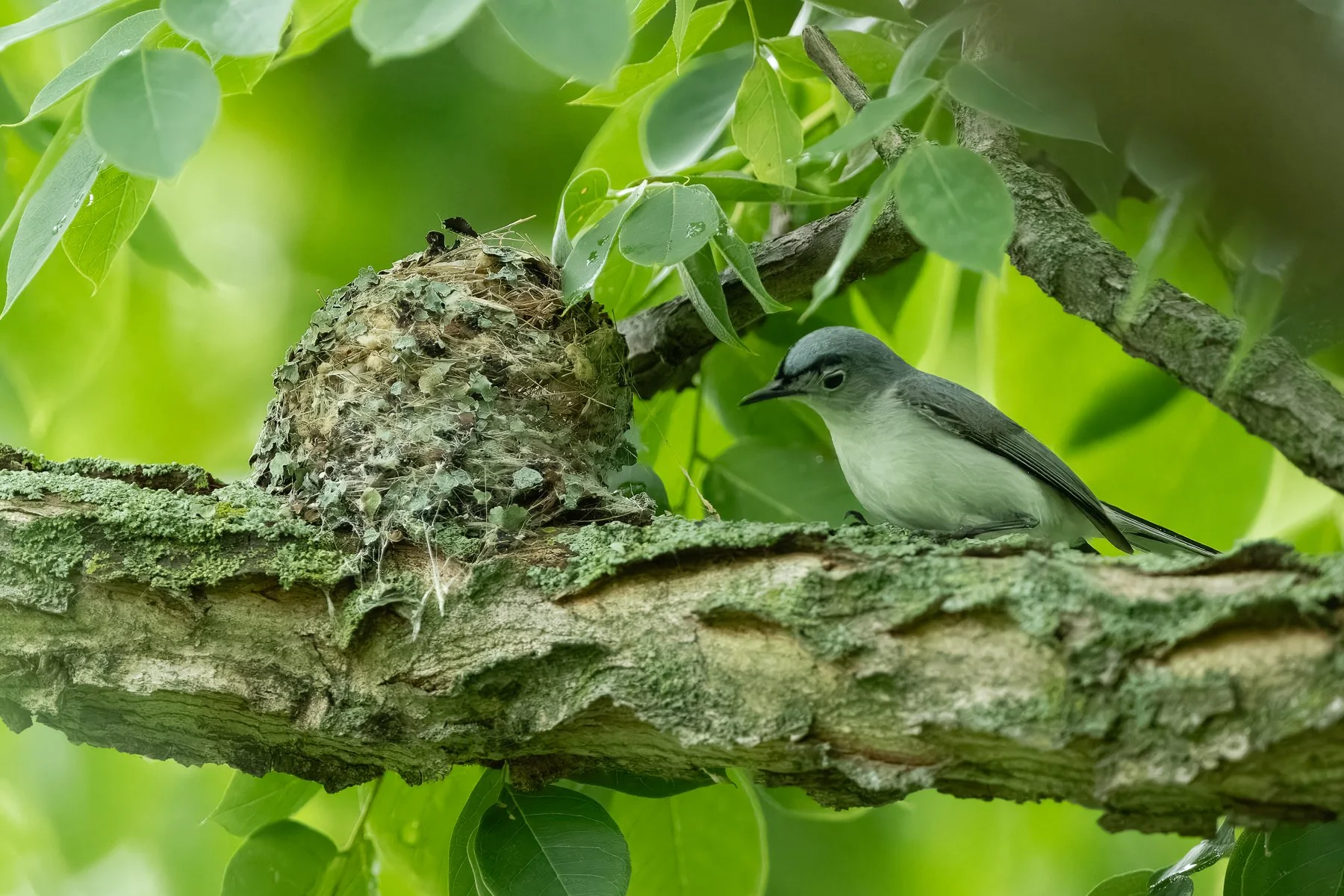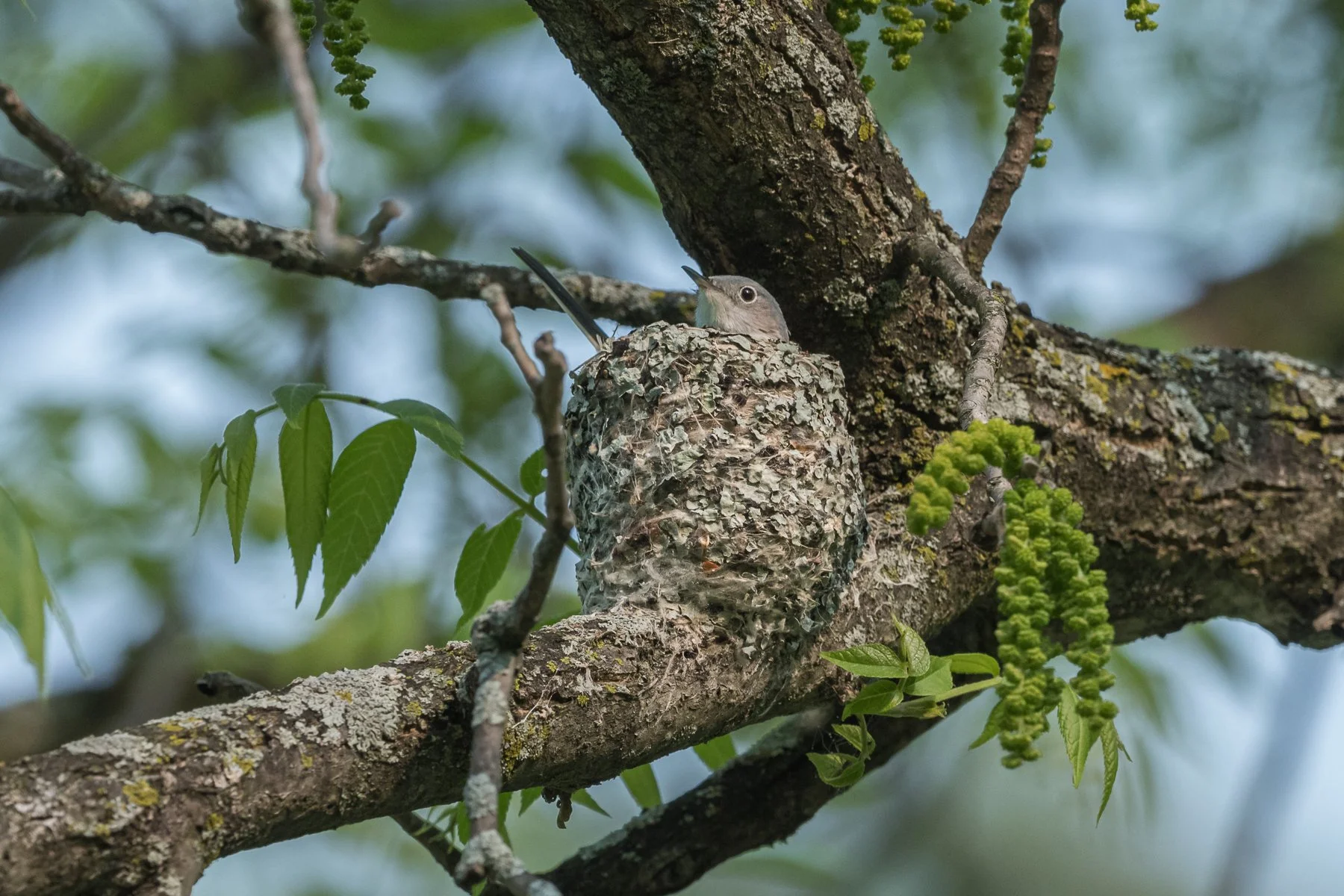On a beautiful early May morning at Fair Meadows Sanctuary, our SoWBA birding outing was nearing the end when one of the participants first heard wheezy spee-spee-spee call notes: a Blue-gray Gnatcatcher! Typical of this small, fast-moving denizen of the treetops, our gnatcatcher was first detected when heard rather than seen. Our sighting was only the beginning. As the male bird moved about high in the white oak above us, he soon led us to the spot where he and his mate were busy constructing their nest, a compact cup positioned on the top of a limb and resembling a tree knot.
Note the black tail with white outer feathers of this adult Blue-gray Gnatcatcher in breeding plumage. The cup-shaped nest in the white oak is well camouflaged on the branch (photo by Gary Shackelford).
The Blue-gray Gnatcatcher is one of four species of gnatcatchers in North America and is the only one that truly migrates. The other three species are found in the southwestern US and Mexico. Our gnatcatcher species is broadly distributed from the northeast Atlantic to the southwest Pacific coasts of the US. It is absent from northern Maine, the northwestern US, and much of the central and northern Great Plains. The breeding habitat varies by geographic region; in our region, gnatcatchers are found mostly in deciduous forests at or near habitat edges. Here, they are common summer residents. In a recent point count bird survey of a 78-acre section of upland woods at Fair Meadows, they were observed at all five observation points and at a single point in a restored prairie near the woodland edge.
Blue-gray Gnatcatchers are very small, slender birds with uniformly blue-gray upperparts, unmarked white underparts, and a prominent white eye ring. Their long tail is black with white outer feathers. The sexes are weakly dimorphic. Males in breeding plumage have a narrow black line across their forehead and supercilium, which is lacking in females. Their most well-known vocalization is their wheezy call notes, uttered in short bursts. Less well known is their song—a complex, rambling series of warbles interspersed with chips and slurs—which is soft, difficult to hear, and sung only by males. Calls can be heard whenever gnatcatchers are present in an area; songs are heard more seldom, peaking early during breeding season.
Breeding male with a nest in a Kentucky coffee-tree. Note the black line across his forehead and supercilium (photo by Gary Shackelford).
Gnatcatchers are active feeders that move quickly through foliage of trees or large shrubs, gleaning food from vegetation or picking items while hovering. Less commonly, they sally after flushed prey to catch it on the wing. While foraging, they conspicuously flick their tail from side to side, which may flush unseen prey. Despite their name, gnats do not constitute a significant part of their diet.
The nest of the Blue-gray Gnatcatcher is a compact cup of exquisite beauty, perhaps equaled in our area only by the nests of the Ruby-throated Hummingbird and Baltimore Oriole. Arthur Cleveland Bent, author of Life Histories of North American Birds, wrote: “More than with most species of small birds, the attention and interest of the observer center about the nesting habits of the blue-gray gnatcatcher [sic] because of the great beauty of its nest.” Nests are about the size of a baseball and are typically saddled well out on a horizontal limb of a deciduous tree, often built against a twig or side branch for support. They are composed of plant fibers, down, and bark strips, which are bound together with insect silk and spider web and covered externally with large quantities of crustose lichens. Nests are so well camouflaged that they are seldom found unless their location is given away by their owners. A peculiar practice of gnatcatchers is their habit of tearing apart a partially built or completed nest and recycling the materials to build a new nest a short distance away. This behavior can especially be a response to nest failure or cowbird parasitism. Two broods are common in the far southern part of their range, but in our area, most pairs are single-brooded.
Female gnatcatcher on a nest in a black walnut. The compact, cup-shaped nest has a layer of lichens covering its surface (photo by Gary Shackelford).
Nesting season at Fair Meadows is well underway. Thus far this year, we have found two gnatcatcher nests, one in a white oak and the other in a Kentucky coffee-tree. True to form, both nests were located on the tops of horizontal limbs. One nest was inexplicably dismantled by its builders shortly after completion; the other was completed, and at last check, the parents were incubating eggs.
Written by Gary Shackelford, Fair Meadows Sanctuary resident manager
Cover image: An adult blue-gray gnatcatcher photographed in Florida during the wintertime (photo by Gary Shackelford).








